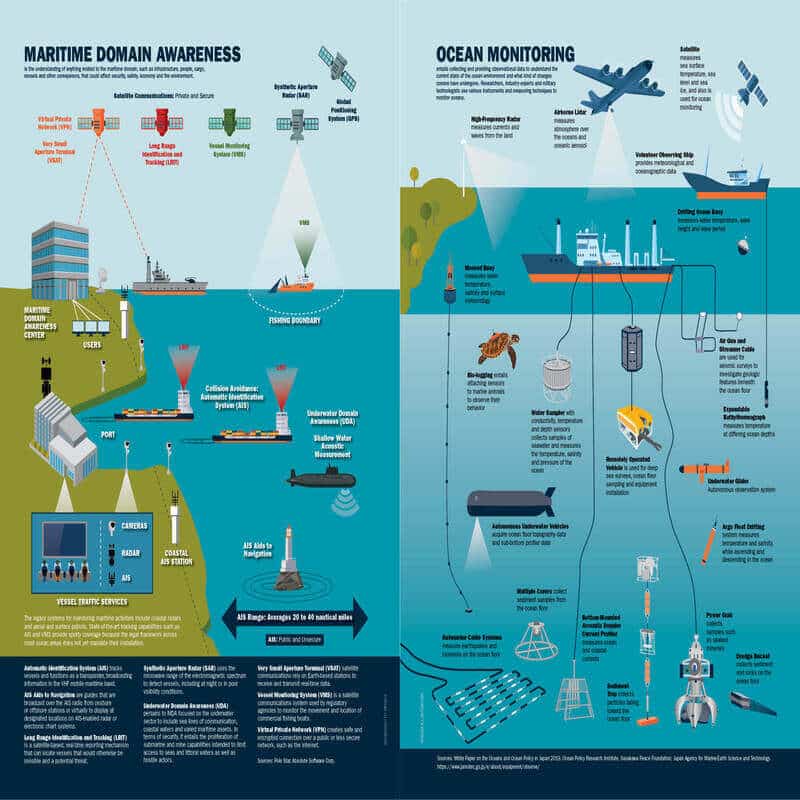
India and the U.S. have identified Underwater Domain Awareness (UDA) technologies for co-production in India, marking a significant step in bilateral defence cooperation. According to sources, India is the first country with which the U.S. defence industry has offered collaboration on such advanced maritime technologies. Read here to learn more.
India and the U.S. have identified several Underwater Domain Awareness (UDA) technologies for co-production in India, strengthening India’s maritime security and surveillance capabilities.
These technologies are crucial for anti-submarine warfare (ASW), intelligence gathering, and undersea monitoring—key areas given the rising presence of submarines, including Chinese vessels, in the Indian Ocean Region (IOR).
The India-U. S collaboration reflects the growing Indo-Pacific strategic partnership and India’s role as a key security partner for the U.S. in the region.
Underwater Domain Awareness (UDA)
Underwater Domain Awareness (UDA) refers to the ability to monitor, detect, and analyze underwater activities in oceans, coastal waters, and inland waterways. It involves the use of advanced sonar, sensors, autonomous systems, and artificial intelligence to track submarines, underwater drones, mines, and other naval threats.
Why is UDA Important?
- National Security – Helps in detecting enemy submarines and potential underwater threats.
- Maritime Surveillance – Ensures monitoring of strategic sea routes, choke points, and Exclusive Economic Zones (EEZs).
- Environmental Monitoring – Tracks underwater pollution, marine biodiversity, and climate-related changes.
- Underwater Resource Management – Supports the exploration of deep-sea minerals, oil, and gas reserves.
- Disaster Management – Assists in monitoring tsunamis, underwater earthquakes, and oil spills.
Key Underwater Domain Awareness (UDA) technologies

- Sonobuoys
Sonobuoys are small, expendable sonar systems deployed from aircraft or ships to detect and track submarines underwater. They are widely used in anti-submarine warfare (ASW) and maritime surveillance.
Types of Sonobuoys Identified for India-U.S. Co-Production
- Passive Sonobuoys – Listen for underwater sounds, such as submarine propeller noise.
- Active Sonobuoys – Emit sonar pulses and listen for echoes to detect objects.
- Multi-Static Sonobuoys – Work in a network to improve detection accuracy.
Significance
- Enhances India’s ASW capabilities, countering potential submarine threats in the Indian Ocean.
- Provides real-time intelligence and early warning systems for naval operations.
- Can be integrated with P-8I Poseidon aircraft, already used by the Indian Navy for maritime surveillance.
- Surveillance Systems
Advanced Underwater Surveillance Systems include fixed sensors, seabed sonar arrays, and mobile platforms to track submarines, underwater drones, and other naval threats.
Potential Technologies for India
- Seabed Sonar Networks – Permanent underwater listening devices deployed along India’s strategic waters.
- Underwater Acoustic Sensors – Used to detect stealth submarines and enemy movements.
- Integrated Undersea Surveillance Systems (IUSS) – A networked system of hydrophones and sonars to monitor vast ocean areas.
Significance
- Enhances coastal defence and submarine detection.
- Helps India monitor adversary naval activities, including Chinese submarines operating in the IOR.
- Improves early warning capabilities, critical for maritime security.
- Unmanned Surface Vehicles (USVs)
Unmanned Surface Vehicles are robotic vessels that operate autonomously or remotely to conduct surveillance, reconnaissance, and ASW missions.
Key USV Technologies for India
- Maritime Autonomous Vehicles (MAVs) – AI-powered drones for surface patrol and surveillance.
- Littoral Combat USVs – Used for naval operations near coastal waters.
- Mine Countermeasure USVs – Detect and neutralize underwater mines.
Significance
- Reduces risks to naval personnel by using autonomous platforms.
- Enhances India’s surveillance along critical chokepoints like the Strait of Malacca and the Andaman Sea.
- Supports joint operations with manned naval vessels, improving maritime security.
- Unmanned Underwater Vehicles (UUVs)
UUVs, or underwater drones, are robotic submarines used for reconnaissance, mine detection, and ASW.
Potential UUVs for India
- Autonomous Underwater Vehicles (AUVs) – Used for deep-sea exploration and intelligence gathering.
- Glider Drones – Passive underwater drones that operate for months, collecting oceanographic data.
- Mine Countermeasure UUVs – Used to locate and destroy underwater mines.
Significance
- Allows long-duration surveillance in enemy waters.
- Supports covert naval operations without risking human lives.
- Strengthens mine warfare capabilities, ensuring safe naval movement.
Strategic Impact on India’s Maritime Security
- Countering Chinese Naval Presence in the Indian Ocean
- China’s increasing submarine activity in the IOR poses a security threat.
- UDA technologies will help India monitor Chinese vessels, particularly near Sri Lanka, Maldives, and the Andaman & Nicobar Islands.
- Strengthening Indo-Pacific Security with the U.S.
- This collaboration aligns with the Quad (India, U.S., Japan, Australia) and Indo-Pacific security strategy.
- Enhances U.S.-India naval interoperability, benefiting joint military exercises like Malabar.
- Boosting India’s Indigenous Defense Industry
- Supports Make in India by transferring high-tech naval systems to Indian manufacturers.
- Helps India develop its unmanned naval assets, reducing reliance on imports.
A Game-Changer for India’s Navy
The India-U.S. partnership on Underwater Domain Awareness (UDA) technologies will revolutionize India’s maritime security, strengthen anti-submarine warfare, and counter regional threats.
This is a major step toward making India a global leader in naval defence technology.
Strengthening Anti-Submarine Warfare (ASW)
One of the most critical challenges in modern naval warfare is detecting and neutralizing stealth submarines. The India-U.S. partnership will bring cutting-edge ASW technologies such as:
- Sonobuoys: These underwater listening devices help detect enemy submarines by capturing acoustic signals. India has already deployed U.S.-made P-8I Poseidon maritime patrol aircraft, which are optimized for sonobuoy-based submarine detection.
- Seabed Sonar Networks: Underwater sensor arrays placed in critical choke points (such as the Strait of Malacca and the Andaman & Nicobar Islands) will enable real-time tracking of submarine movements.
- Autonomous Underwater Vehicles (AUVs): These AI-powered drones will patrol the depths of the ocean, gathering intelligence and assisting in mine countermeasures.
- India will gain an early-warning system against enemy submarines, reducing the risk of surprise attacks.
- Strengthens India’s ability to counter China’s growing naval presence in the Indian Ocean.
- Helps safeguard critical sea lanes of communication (SLOCs) essential for trade and energy supply.
Enhancing Maritime Surveillance and Intelligence
The partnership will introduce state-of-the-art surveillance systems for real-time monitoring of oceanic activities. Key technologies include:
- Integrated Undersea Surveillance Systems (IUSS): A network of deep-sea sensors that track ship and submarine movements over vast areas.
- Satellite-Based Ocean Monitoring: High-resolution satellites will detect anomalies in ocean currents caused by submarine movements.
- AI-Powered Threat Analysis: Artificial intelligence will process sonar and sensor data to predict enemy manoeuvres and enhance situational awareness.
- Provides 24/7 surveillance of India’s vast coastline and EEZ (Exclusive Economic Zone).
- Strengthens coastal security, helping prevent illegal activities such as smuggling, piracy, and terrorism.
- Supports India’s blue economy initiatives by monitoring deep-sea resource extraction.
Countering Regional Threats in the Indian Ocean
India faces multiple maritime challenges, including:
- Chinese Naval Expansion: China has significantly increased its submarine patrols and military presence in the Indian Ocean through its String of Pearls strategy (bases in Djibouti, Pakistan’s Gwadar, Sri Lanka’s Hambantota, etc.).
- Piracy and Terrorism: The waters off Somalia and the Malacca Strait remain piracy hotspots, while state-sponsored maritime terrorism is a growing concern.
- Illegal Fishing and Resource Exploitation: Foreign vessels illegally exploit India’s EEZ, impacting national security and the economy.
- India will be able to track and counter Chinese submarines before they enter critical areas.
- Strengthens India’s naval dominance in the Indo-Pacific, deterring aggressive actions by adversaries.
- Supports law enforcement and conservation efforts in India’s maritime zones.
India’s Path to Becoming a Global Leader in Naval Defense Technology
This partnership will not only enhance India’s security but also position it as a major player in naval defence technology. Key advantages include:
Boosting India’s Indigenous Defense Industry
- Technology Transfer: The U.S. will share key defence technologies, allowing Indian firms to manufacture high-end naval equipment under the Make in India initiative.
- Collaborative R&D: Indian and American defence companies will co-develop next-generation UDA solutions, reducing reliance on imports.
- Skill Development: Indian engineers and scientists will gain expertise in AI-driven underwater warfare, sonar technology, and autonomous naval systems.
- Enhances India’s defence self-sufficiency and reduces dependence on costly foreign procurements.
- Creates high-tech jobs and boosts the Indian defence economy.
- Positions Indian companies as global exporters of UDA technology.
Strengthening Indo-U.S. Defense Ties
- This initiative aligns with Quad (India, U.S., Japan, Australia) and the Indo-Pacific security strategy.
- It enhances joint naval exercises like Malabar, where Indian and U.S. forces can train with new UDA systems.
- Strengthens defence diplomacy, reinforcing India’s role as a strategic U.S. partner in countering China.
- India emerges as a key player in Indo-Pacific security affairs which will strengthen India’s position in global military alliances.
Future of India’s UDA Capabilities
With continuous advancements in AI, automation, and deep-sea surveillance, India’s future UDA ecosystem will include:
- AI-driven sonar systems that can detect ultra-quiet submarines.
- Underwater swarm drones that work in groups for advanced intelligence gathering.
- Quantum-based sonar for detecting stealth submarines undetectable by traditional methods.
- Underwater fibre-optic networks for real-time deep-sea monitoring.
Conclusion
The India-U.S. partnership on Underwater Domain Awareness (UDA) technologies is a historic step that will revolutionize India’s maritime security, enhance anti-submarine warfare, and solidify India’s position as a global naval power.
With Indigenous production, AI-driven surveillance, and cutting-edge naval systems, India is well on its way to becoming a leader in underwater defence technology in the coming decade.
Frequently Asked Questions (FAQs)
Q. What are the technologies for maritime domain awareness?
Ans: Technologies such as satellite surveillance, automatic identification systems (AIS), and AI often enhance maritime domain awareness by providing real-time insights and improving decision-making.
Related articles:





Leave a Reply